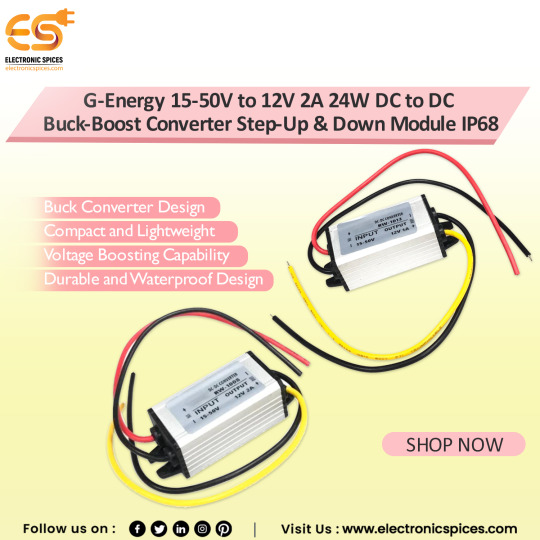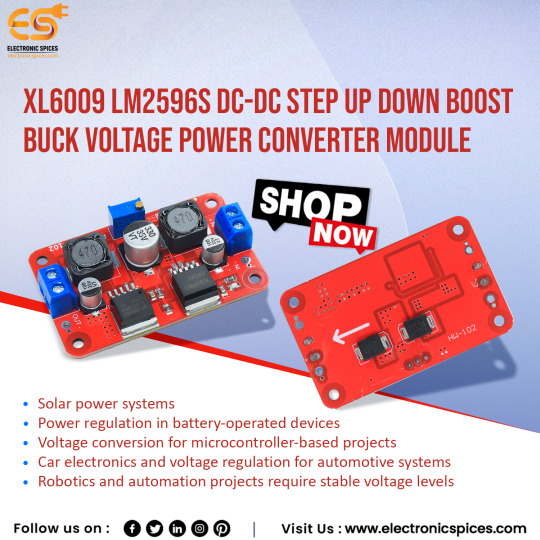#BuckBoostConverter
Explore tagged Tumblr posts
Text
𝐆-𝐄𝐧𝐞𝐫𝐠𝐲 𝟏𝟓-𝟓𝟎𝐕 𝐭𝐨 𝟏𝟐𝐕 𝟐𝐀 𝟐𝟒𝐖 𝐃𝐂 𝐭𝐨 𝐃𝐂 𝐁𝐮𝐜𝐤-𝐁𝐨𝐨𝐬𝐭 𝐂𝐨𝐧𝐯𝐞𝐫𝐭𝐞𝐫 𝐒𝐭𝐞𝐩-𝐔𝐩 & 𝐃𝐨𝐰𝐧 𝐌𝐨𝐝𝐮𝐥𝐞 𝐈𝐏𝟔𝟖

The G-Energy 15-50V to 12V 2A 24W DC-DC Buck-Boost Converter is a cutting-edge power module that offers a perfect blend of versatility, efficiency, and durability. This makes it an indispensable component for a wide range of applications demanding a stable 12V output, even in the face of fluctuating input voltages. Whether you're powering off-grid solar systems, automotive electronics, communication devices, or low-power 12V devices, this converter is designed to meet your power conversion needs with utmost efficiency.
Key Features and Benefits :
Wide Input Voltage Range: One of the most significant advantages of the G-Energy Buck-Boost Converter is its exceptionally wide input voltage range, spanning from 15V to 50V. This flexibility ensures its compatibility with various applications where input voltages within this range are prevalent, such as automotive, solar, and industrial environments. The ability to handle such a broad input voltage range is especially beneficial for off-grid solar power systems, where solar panel voltage can fluctuate based on factors like time of day, weather conditions, and load demands.
Dual-Function Capability (Boost and Buck): The G-Energy 15-50V converter is a versatile device capable of performing both step-up (boost) and step-down (buck) voltage conversion. This means it can either increase or decrease the input voltage to deliver a constant 12V output, as required.
Boost Mode: If the input voltage is below 12V, the converter will boost it to the desired 12V level.
Buck Mode: If the input voltage exceeds 12V, the converter will buck it down to the required 12V output.
High Efficiency: The G-Energy converter is engineered to deliver high efficiency, ensuring minimal power loss during the conversion process. This translates to lower heat dissipation and improved overall system performance.
Compact and Durable Design: The compact and robust design of the G-Energy converter makes it easy to integrate into various applications. Its durable construction ensures long-lasting performance, even in harsh operating conditions.
Applications :
Off-Grid Solar Power Systems: Powering 12V devices like LED lights, fans, and small appliances.
Automotive Electronics: Providing stable 12V power to car accessories and electronics.
Communication Devices: Powering routers, modems, and other communication equipment.
Industrial Automation: Powering sensors, actuators, and control systems.
Battery Charging: Charging 12V batteries from various input voltage sources.
#Electronicspices#GEnergyConverter#DCtoDCConverter#BuckBoostConverter#StepUpDownModule#IP68Converter#24WPowerConverter#EnergyEfficiency
0 notes
Text
DC-to-DC converters and their Types
January 2, 2025
by dorleco
with no comment
Others
Edit
Introduction

The DC-to-DC converter is an essential component of modern commercial and industrial electronics. These devices are critical for increasing the efficiency and stability of systems that rely on precise voltage regulation. A thorough understanding of the many types of DC-to-DC converters and their characteristics is essential for maximizing performance and dependability.
Choosing the improper sort of DC-to-DC converter can result in reduced efficiency, reliability, and performance. Fortunately, Dorleco is here to assist you in selecting the right converter for your needs, giving you piece of mind. By the end of this article, you’ll know the differences between buck, boost, and buck-boost converters, allowing you to make more informed judgments. Dorleco not only provides knowledgeable guidance, but also high-quality converters that are suited to your specific requirements.
Function of DC-to-DC Converters
Before delving into the many types of DC-to-DC converters, it’s important to grasp their basic function. These devices take a defined DC input voltage and convert it to a different DC output voltage according on the system needs.
This conversion guarantees that all equipment performs at maximum efficiency by providing the necessary voltage. From production automation to renewable energy installations, DC-to-DC converters are the foundation of dependable industrial systems.
Improving Efficiency in Electronic Devices
Efficiency is an important consideration in the operation of electrical equipment, particularly in commercial and industrial settings. DC-to-DC converters optimize voltage conversion, lowering power loss and improving energy efficiency.
Efficiency is critical for battery-operated devices, such as warehouse robots. Efficient converters enhance battery life, reduce replacements, and promote environmental sustainability. Furthermore, they reduce the amount of heat produced during operation, lowering the need for sophisticated cooling systems and preserving energy.
High-efficiency converters also reduce operational costs, which extends the life of linked devices. Dorleco’s blog provides thorough information on power supply efficiency ratings.
Ensure voltage stability and control.
The sentence could not be directly located in the document. Could you confirm the exact phrasing or provide more context? DC-to-DC converters adjust output voltage to ensure that connected equipment operates within its ideal range. This stability protects delicate electronic components from being damaged by voltage fluctuations.
In businesses requiring precision, such as medical equipment and telecommunications, controlled and constant voltage is critical. Converters also help to control dynamic loads by modifying the voltage supply to match the changing demands of system components.
Types of DC-to-DC Converters:

1. Buck Converters: Utilizing Step-Down Capabilities
The buck converter is one of the most popular DC-to-DC converters because it can step down greater input voltages to lower output levels. These converters are appropriate for situations in which the power supply exceeds the load’s voltage needs.
Applications:
Automatic equipment
LED lighting systems.
Small motors in larger systems operate at greater voltages.
Key Advantages:
High efficiency with low heat generation.
Reduced operational costs.
Increased longevity for both the converter and the connected devices.
How It Works:
The core of a buck converter comprises a switch, a diode, and an inductor.
When the switch closes, energy is stored in the inductor.
This energy is released when the switch is opened, resulting in a voltage decrease.
The switch’s functioning determines the output voltage level.
2. Boost Converters: Stepping Up Voltage
Boost converters enhance the input voltage, making them necessary in situations where a greater output voltage is required. These are especially useful in energy harvesting applications like solar panels and battery-powered devices.
Applications:
Renewable energy systems.
Communication Devices
Remote sensors
Key Advantages:
Allows greater voltage levels for maximum performance.
Promotes energy-efficient power supply systems.
How It Works:
An inductor stores energy when the switch is closed.
When the switch opens, a diode transfers this energy to the output, increasing the voltage.
The period of the switch’s closure or opening impacts the voltage gain.
3. Buck-Boost Converters Offer Flexibility for Variable Voltage Sources
Buck-boost converters combine the functions of buck and boost converters, providing the ability to step up or down voltage as needed. Because of their versatility, they can be used in systems with diverse power sources.
Applications:
Portable electronics
Automotive systems
Devices using variable power sources
Key Advantages:
Versatility in a variety of applications.
seamless integration into complex systems.
Selecting the Right DC-to-DC Converter
The efficacy and efficiency of your electrical system are strongly dependent on choosing the right DC-to-DC converter. The type of power supply, load requirements, and application-specific needs are all important considerations.
4. Matching Applications and Converter Types:

Buck converters: Ideal for step-down voltage applications, such as powering LED lights or sensors in industrial environments.
Boost Converters : Ideal for applications requiring higher voltage, such as solar energy systems or remote sensors.
Buck-Boost Converters: Suitable for applications with variable power sources, they offer adaptability and stability.
Key Factors to Consider When Choosing a DC-to-DC Converter
Efficiency and heat dissipation:
High efficiency reduces energy loss and system heat.
Choose converters with effective heat dissipation, especially for small or high-temperature applications.
Input/output voltage and current requirements:

Identify the specific voltage and current requirements for your application.
Ensure that the converter satisfies these specifications.
Dimensions and Mounting restrictions:
Consider how much physical space is available for the converter.
Choose form factors that work perfectly with your system.
Environmental Factors:
Evaluate the working conditions, including vibrations, dampness, and dust.
Safety and Regulatory Compliance:
Examine conformity with industry standards and safety legislation.
Look for features such as thermal shutdown, under-voltage lockout, and over-voltage protection.
Conclusion
Understanding the various types of DC-to-DC converters — Buck, Boost, and Buck-Boost — is critical for improving the performance of your electronic systems. By choosing the correct converter, you can improve efficiency, ensure dependability, and keep voltage stable in your operations.
Dorleco is here to assist you explore these options and give solutions that are suited to your specific requirements. Visit our blog to learn more about power supplies, their applications, and troubleshooting hints. To inquire or place an order of our products VCUs, CAN Displays & CAN Keypads , & Services ,please email us at [email protected]. Allow us to assist you in determining the best power conversion option for your needs.
0 notes
Video
instagram
Top 10 EEE Projects #electricalengineering #buckboostconverter #powerelectronics #electrical Visit pantechsolutions.net https://www.instagram.com/p/B63MIQHn7Fk/?igshid=1e1iekujughxh
0 notes
Text
𝐗𝐋𝟔𝟎𝟎𝟗 𝐋𝐌𝟐𝟓𝟗𝟔𝐒 𝐃𝐂-𝐃𝐂 𝐒𝐭𝐞𝐩 𝐔𝐩 𝐃𝐨𝐰𝐧 𝐁𝐨𝐨𝐬𝐭 𝐁𝐮𝐜𝐤 𝐕𝐨𝐥𝐭𝐚𝐠𝐞 𝐏𝐨𝐰𝐞𝐫 𝐂𝐨𝐧𝐯𝐞𝐫𝐭𝐞𝐫 𝐌𝐨𝐝𝐮𝐥𝐞

Specification :-
Input: 3.5-28V
Output: 1.25V-26V
Maximum Input Current: 3A
Maximum Output: 3A
Rated Input: 1A, Output: 1A
Size: 60mm x 37mm
The XL6009 LM2596S DC-DC Step Up Down Boost Buck Voltage Power Converter Module is a versatile and efficient power regulation module that can both step up (boost) and down (buck) input voltage to deliver a stable output. Equipped with the XL6009 and LM2596S chipsets, this converter module allows for wide input voltage ranges and precise output voltage control, making it ideal for various electronic applications requiring different voltage levels. The module operates efficiently in both buck (step-down) and boost (step-up) modes, supporting input voltages typically ranging from 3V to 40V. It can output a regulated voltage anywhere from 1.25V to 35V, depending on the application needs. The built-in potentiometer allows users to adjust the output voltage easily. Additionally, its high conversion efficiency reduces energy loss, and the module is equipped with thermal and short-circuit protection for reliability and safety.
Applications :-
Power regulation in battery-operated devices.
Voltage conversion for microcontroller-based projects.
Solar power systems.
Car electronics and voltage regulation for automotive systems.
Robotics and automation projects require stable voltage levels.
XL6009 LM2596S DC-DC Step Up Down Boost Buck Voltage Power Converter Module
Product Description :
The XL6009 LM2596S DC-DC Step Up Down Boost Buck Voltage Power Converter Module is a versatile and efficient power regulation solution capable of both boosting and bucking input voltage to deliver a stable output. Powered by the XL6009 and LM2596S chipsets, this module offers wide input voltage compatibility and precise output voltage control, making it suitable for a broad range of electronic applications.
Key Features :
Bi-directional voltage conversion: Can step up or step down voltage.
Wide input voltage range: Typically operates from 3V to 40V.
Adjustable output voltage: Potentiometer allows for easy output voltage adjustment.
High conversion efficiency: Minimizes power loss and improves overall efficiency.
Thermal and short-circuit protection: Ensures reliability and safety.
Applications :
Battery-powered devices : Provides stable power supply for devices like smartphones, tablets, and portable speakers.
Microcontroller-based projects : Offers a reliable power source for various microcontroller applications.
Solar power systems : Regulates voltage from solar panels to match the requirements of connected devices.
0 notes